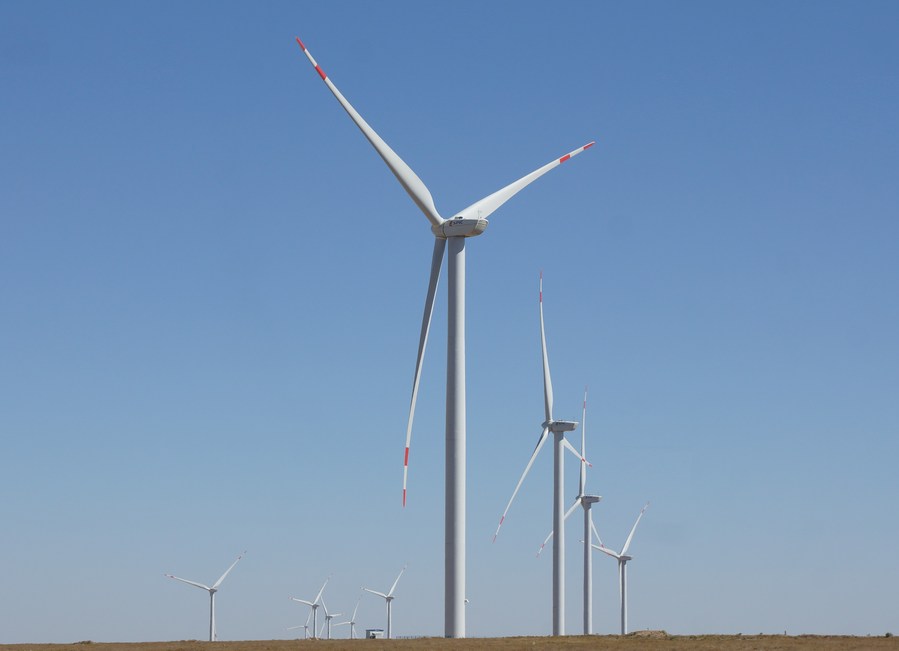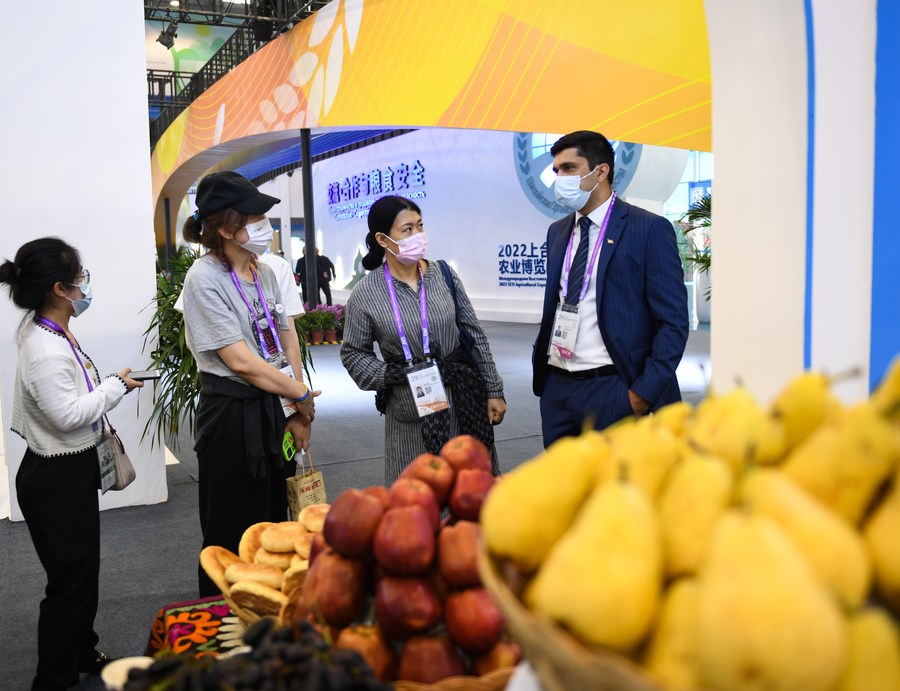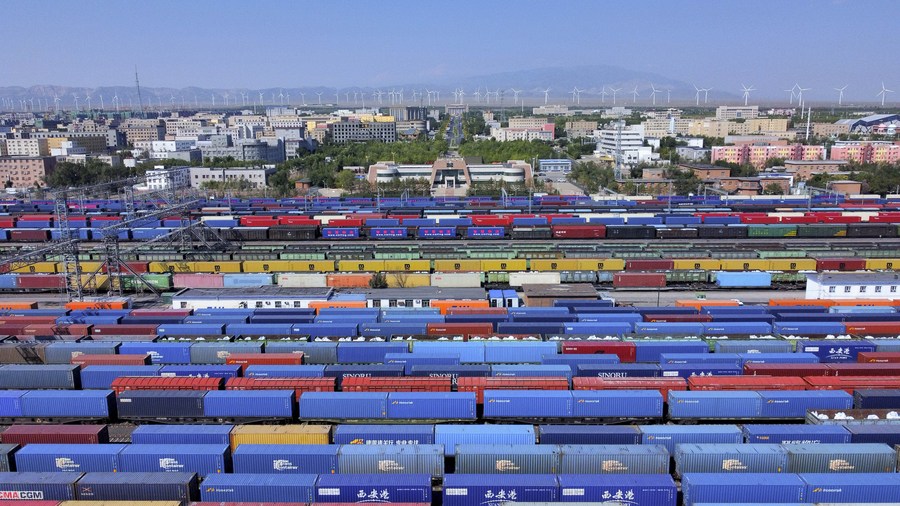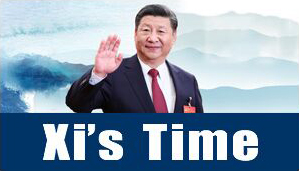
Photo taken on Sept. 13, 2022 shows some wind turbines at the 100-MW Zhanatas wind farm near the city of Zhanatas in the Zhambyl Region, Kazakhstan. (Photo by Dmitry Vasilenko/Xinhua)
Since China proposed the Belt and Road Initiative in 2013, China and five Central Asian countries -- namely Kazakhstan, Kyrgyzstan, Tajikistan, Turkmenistan and Uzbekistan -- have stepped up their cooperation for greater regional development.
BEIJING, Feb. 20 (Xinhua) -- More than 2,000 years ago, an emissary from China's Han Dynasty traveled westward on a mission of peace and opened an overland route linking the East and the West. Spanning thousands of miles and years, the ancient Silk Road, with its longest part lying across the territory of Central Asia, has embodied the spirit of cooperation, mutual learning and mutual benefit.
Since China proposed the Belt and Road Initiative (BRI) in 2013, China and five Central Asian countries -- namely Kazakhstan, Kyrgyzstan, Tajikistan, Turkmenistan and Uzbekistan -- have stepped up their cooperation for greater regional development. Last week they held a first-ever forum on industry and investment cooperation, which refreshed the age-old Silk Road.
In a congratulatory letter addressed to the two-day forum opened Thursday in east China's coastal city of Qingdao, Chinese President Xi Jinping said deepening industry and investment cooperation between China and the five countries of Central Asia will safeguard the stability of regional industrial and supply chains, promote regional industrial development, increase engagement in world's economic activities, and boost common prosperity.
COMMON DEVELOPMENT
Since the establishment of their diplomatic relations three decades ago, China and the five Central Asian countries have developed strategic partnerships and established a new path of good-neighborliness, friendship and win-win cooperation, thereby setting up a paradigm for a new type of international relations.
Focusing on promoting high-quality development of regional economy through mutually beneficial cooperation, the forum brought together representatives from political and business circles, eyeing greater cooperation in sectors such as the digital economy, energy and agriculture.
The idea on holding the forum started from the virtual summit commemorating the 30th anniversary of diplomatic relations between China and the five countries held on Jan. 25, 2022 when Xi put forward the initiative on holding the forum.
During the summit that marked the first collective meeting among the C+C5 heads of state, Xi called on the six countries to magnify the exemplary role of good-neighborly friendship, build a cooperation belt for high-quality development, strengthen the shield for defending peace, build a family with diverse interactions, and protect the global village that enjoys peace and development.
The five-point proposal has been welcomed by the leaders of the five Central Asian countries. Under the guidance of their leaders, relations between China and Central Asian countries have gained new momentum.

People visit a booth displaying fruits from Tajikistan at the 29th China Yangling Agricultural Hi-tech Fair in Yangling, northwest China's Shaanxi Province, Sept. 15, 2022. (Photo by Zou Jingyi/Xinhua)
Official figures showed that China's trade with the five Central Asian countries totaled 70.2 billion U.S. dollars in 2022, some 100 times of the volume 30 years ago.
Meanwhile, as the BRI has become a popular international public good and platform for international cooperation, China and Central Asian countries have successfully implemented multiple infrastructure projects under the framework of the initiative.
As Xi said in the congratulatory letter to the forum, China is willing to share with the Central Asian countries the super-large market, complete industrial system and advanced technologies, deepen pragmatic cooperation, achieve mutual benefit and win-win results, work together to promote high-quality development of regional economy, and build a closer community with a shared future.
COOPERATION IN AGRICULTURE, ENERGY
Agriculture has been a major area for cooperation between China and Central Asian countries. A great variety of Central Asian agricultural products have entered the Chinese market, including camel milk from Kazakhstan, honey from Kyrgyzstan, dried fruits from Tajikistan, cotton from Turkmenistan, and cherries from Uzbekistan.
The first China + Central Asia industry and investment cooperation forum has provided agricultural companies from both sides with another opportunity to expand their businesses.
"I'm here looking for a Central Asian supplier with the freshest nuts," said Wang Baohua, manager of Jingxiang Food Technology Co., Ltd., which produces mainly sesame paste and other condiments in the city of Heze, Shandong Province.
Having imported sunflower seeds and sesame seeds from Central Asian countries for years, the company is expected to increase its production capacity tenfold this year and plans to open a factory and carry out technical cooperation in Central Asia.
Another field of their growing cooperation is energy industry.
Tajikistan had suffered for years a severe power shortage in winter as it used to rely on hydropower that went down drastically during the dry season.

Aerial photo taken on Oct. 9, 2018 shows the Dushanbe No. 2 thermal power station in Dushanbe, Tajikistan. (Xinhua/Zhang Ruoxuan)
In 2011, the Tajik government and China's TBEA energy company jointly launched the project of the Dushanbe-2 thermal power station, a combined heat and power plant with a total installed capacity of 400 megawatts. Completed in 2016, the station enabled the restart of central heating for Dushanbe residents after a 15-year hiatus.
In Uzbekistan, a chemical complex cooperation project under the framework of the BRI has changed the country's dependence on imports of polyvinyl chloride, caustic soda, and created a large number of new jobs, which is of great significance to the economic development of the country.
So far, China and the five Central Asian countries have agreed to launch dozens of major projects on production capacity cooperation, covering automobiles, energy, metallurgy, chemical industry and medicine, with a total investment of over 20 billion dollars.
INTERCONNECTIVITY
Since the BRI was put forward in 2013, it has vigorously promoted interconnection among countries along the route and advanced regional economic development, especially in landlocked Central Asia.
During Xi's state visit to Uzbekistan in September 2022, China, Kyrgyzstan and Uzbekistan signed a memorandum of understanding on cooperation on the Kyrgyz section of the China-Kyrgyzstan-Uzbekistan railway, making significant headway in the construction of a transport corridor in the Eurasian continent.

This aerial photo taken on Sept. 10, 2022 shows China-Europe freight trains at the Alataw Pass, northwest China's Xinjiang Uygur Autonomous Region. (Photo by Chen Qian/Xinhua)
The China-Europe freight trains through Central Asia, the China-Kazakhstan Horgos International Frontier Cooperation Center, and the China-Kazakhstan International Logistics Base in the eastern Chinese port of Lianyungang have all helped open the door to global markets for Central Asian countries. The enhanced interconnectivity has also encouraged many Chinese companies to invest in the region.
In late 2016, Xi'an Aiju Grain and Oil Industrial Group completed the construction of a 300,000-ton oil processing plant in Kazakhstan. Liu Dongmeng, deputy general manager of the group, told Xinhua that the group has also signed 100,000 hectares (1,000 square km) of land for transnational contract farming in northern Kazakhstan.
He recalled that back in March 2016, Aiju group imported 2,000 tons of non-Genetically Modified Organism (GMO) high-quality oil from Kazakhstan, taking the first Chang'an China-Europe freight train.
"We are beneficiaries of the Belt and Road construction," Liu said, adding they have also established a joint laboratory with China's Northwest A&F University and Kazakh National Agrarian University.
With the completion of a number of projects, a comprehensive connectivity network linking China and the five Central Asian countries, is taking shape. The network, which includes roads, railways, aviation as well as oil and gas pipelines, has contributed to the stability of industrial chains and supply chains in Asia and Europe.

Staff members pose for photos with the first "Shanghai Express" in Hamburg, Germany, on Oct. 26, 2021. (Xinhua/Wang Qing)
Since the "Shanghai Express" of the China-Europe freight trains launched an international route to Central Asia in July 2022, the huge trade potential between China and Central Asian countries has been fully released. Commodities from both sides have been transported through the freight trains and then shipped to other parts of the world.
Projects under the BRI have demonstrated how effective cooperation can transform the concept of "building a community with a shared future for mankind" into practical reality, said Almas Chukin, a prominent Kazakh economist.
"President Xi Jinping's idea is that by joint efforts and by understanding the community with a shared future for mankind, we are in a win-win situation ... and it ensures the prosperity of all countries that can develop and work together," Chukin said. Enditem
(Zhao Yan, Zhang Xu, Xu Ke, Dong Xue, and Zhu Chao in Beijing, Yuan Min, Wang Kai, and Li Baojie in Jinan, Cai Guodong in Tashkent, and Guan Jianwu in Bishkek contributed to the story.) ■




